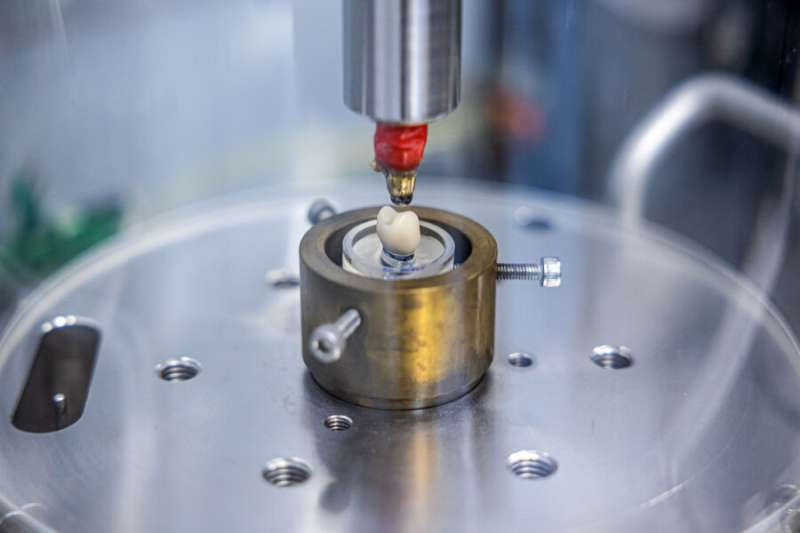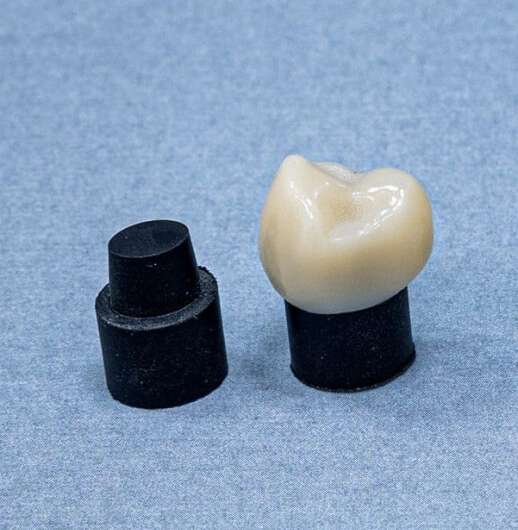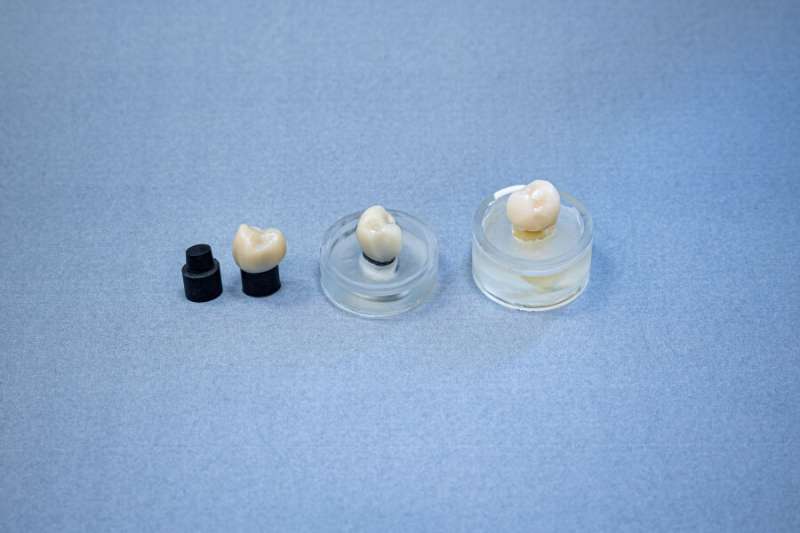Fibre-reinforced composite elliptical frustums - dentine analogue material (substrate) in ceramic crown fatigue test. Credit: The University of Hong Kong
Extracted human teeth have long been used in conducting dental research, such as evaluating dental ceramic materials as a crown restoration on tooth. It is an inexpensive and straightforward process that simulates clinical situations. However, the collection and use of extracted human teeth is becoming increasingly difficult given the concerns about COVID-19, size-standardization issues, and also time constraints. All these factors have prompted a need for dentine analog materials that could potentially substitute extracted human teeth in laboratory-based mechanical and fatigue tests.
A research team led by Dr. James Tsoi, Associate Professor in Dental Materials Science from the Faculty of Dentistry at the University of Hong Kong (HKU), together with colleagues from Wuhan University, China, and Drexel University, U.S., investigated new elliptical frustums of fiber-reinforced composite materials and compared their properties to that of human dentine.
The materials were tested for their mechanical strength, elastic modulus, indentation hardness and fatigue behavior. Fatigue behavior indicates the tenacity of materials under varying loads. The positive results showed that the dentine analog materials analyzed can be used as a replacement for human-extracted teeth.
The study, titled "Which dentine analogue material can replace human dentine for crown fatigue test?" has been published online in the journal Dental Materials. Based on this study, a dental company contracted the Faculty of Dentistry to test commercial ceramic products using the same methodology.
The researchers uniformly fabricated the new dentine analog materials with specific size and shape mimicking natural teeth, adhesively bonded to lithium disilicate crowns, and subjected to fatigue loading—the restorations showed comparable fatigue failure load and lifetime (durability) to those based on extracted human teeth. This implies that the materials can be well used in lieu of human-extracted teeth.
-
Dentine analogue material substrate and substrate in ceramic crown. Credit: The University of Hong Kong
-
Dentine analogue material substrate compared with extracted human teeth (right side of photo) in ceramic crown. Credit: The University of Hong Kong
Finite element analysis, an important method to simulate a physical phenomenon using a numerical technique, also showed promising results. Similar stress levels and distributions between dentine analog materials and extracted human teeth were observed. Notably, it is pivotal that the new materials have similar elastic properties and fatigue performance to human dentine if researchers want to use them for laboratory fatigue tests.
"This study evaluated the mechanical properties and fatigue behavior of dentine analog materials experimentally, analytically and numerically, and found a material with spectacular size and shape can reliably replace human dentine as the substrate in a ceramic crown fatigue test," said principal investigator Dr. James Tsoi.
"We hope this study can help researchers who are facing the problem of inadequate extracted human teeth and facilitate predictable laboratory research with the aid of dentine analog materials," he added.
More information: Yanning Chen et al, Which dentine analogue material can replace human dentine for crown fatigue test?, Dental Materials (2022). DOI: 10.1016/j.dental.2022.11.020
Provided by The University of Hong Kong


























